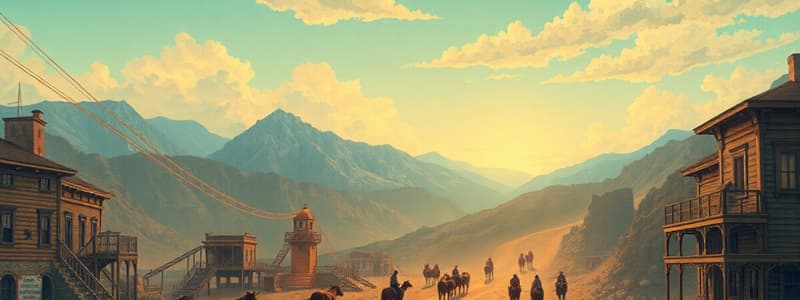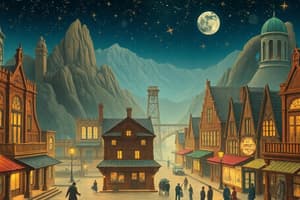Podcast
Questions and Answers
The 1859 discovery of silver ore in Nevada that sparked a mining boom was called the _____ Comstock Lode
The 1859 discovery of silver ore in Nevada that sparked a mining boom was called the _____ Comstock Lode
Comstock Lode
The method of extracting minerals by sifting through river sediments using simple tools was known as _____ Placer mining
The method of extracting minerals by sifting through river sediments using simple tools was known as _____ Placer mining
Placer mining
The process of extracting deep underground minerals that required heavy machinery and corporate investment was called _____ Quartz mining
The process of extracting deep underground minerals that required heavy machinery and corporate investment was called _____ Quartz mining
Quartz mining
A self-appointed group that enforced the law in mining towns when official law enforcement was absent was called a _____ Vigilance committee
A self-appointed group that enforced the law in mining towns when official law enforcement was absent was called a _____ Vigilance committee
The vast open grasslands where cattle could roam freely before the rise of barbed wire fencing was called the _____ Open range
The vast open grasslands where cattle could roam freely before the rise of barbed wire fencing was called the _____ Open range
The long journey that cowboys took to move cattle from Texas to railroad hubs was called the _____ Long drive
The long journey that cowboys took to move cattle from Texas to railroad hubs was called the _____ Long drive
The famous cattle trail that led from Texas to Abilene, Kansas, was the _____ Chisholm Trail
The famous cattle trail that led from Texas to Abilene, Kansas, was the _____ Chisholm Trail
Stray calves that had no identifying brand were known as _____ Mavericks
Stray calves that had no identifying brand were known as _____ Mavericks
The invention that ended the open range system by allowing settlers to fence off their land cheaply was _____ Barbed wire
The invention that ended the open range system by allowing settlers to fence off their land cheaply was _____ Barbed wire
The 1862 law that provided 160 acres of free land to settlers who farmed it for five years was the _____ Homestead Act
The 1862 law that provided 160 acres of free land to settlers who farmed it for five years was the _____ Homestead Act
The nickname given to settlers who plowed the tough soil of the Great Plains was _____ Sodbusters
The nickname given to settlers who plowed the tough soil of the Great Plains was _____ Sodbusters
The farming technique that involved planting seeds deep underground to reach moisture was called _____ Dry farming
The farming technique that involved planting seeds deep underground to reach moisture was called _____ Dry farming
The region of the Great Plains that became a major agricultural center due to wheat farming was called the _____ Wheat Belt
The region of the Great Plains that became a major agricultural center due to wheat farming was called the _____ Wheat Belt
Large, highly mechanized farms that operated like businesses and produced massive wheat harvests were called _____ Bonanza farms
Large, highly mechanized farms that operated like businesses and produced massive wheat harvests were called _____ Bonanza farms
The 1887 law that aimed to assimilate Native Americans by dividing tribal lands into individual plots was the _____ Dawes Act
The 1887 law that aimed to assimilate Native Americans by dividing tribal lands into individual plots was the _____ Dawes Act
The 1876 battle where the Lakota Sioux and Cheyenne defeated General Custer and his men was called the _____ Battle of the Little Bighorn
The 1876 battle where the Lakota Sioux and Cheyenne defeated General Custer and his men was called the _____ Battle of the Little Bighorn
The tragic 1890 event where U.S. troops killed over 200 Lakota men, women, and children was the _____ Wounded Knee Massacre
The tragic 1890 event where U.S. troops killed over 200 Lakota men, women, and children was the _____ Wounded Knee Massacre
The religious movement among Native Americans that aimed to restore their traditional way of life and bring back the buffalo was the _____ Ghost Dance
The religious movement among Native Americans that aimed to restore their traditional way of life and bring back the buffalo was the _____ Ghost Dance
The Sioux leader who resisted U.S. government policies and was killed by Indian police in 1890 was _____ Sitting Bull
The Sioux leader who resisted U.S. government policies and was killed by Indian police in 1890 was _____ Sitting Bull
The event in 1889 where thousands of settlers rushed to claim land in Oklahoma was called the _____ Oklahoma Land Rush
The event in 1889 where thousands of settlers rushed to claim land in Oklahoma was called the _____ Oklahoma Land Rush
What was the significance of the Comstock Lode?
What was the significance of the Comstock Lode?
Why was barbed wire important in the West?
Why was barbed wire important in the West?
What challenges did homesteaders face on the Great Plains?
What challenges did homesteaders face on the Great Plains?
How did the Dawes Act impact Native American communities?
How did the Dawes Act impact Native American communities?
What led to the conflict at the Battle of the Little Bighorn?
What led to the conflict at the Battle of the Little Bighorn?
What was the purpose of the Ghost Dance?
What was the purpose of the Ghost Dance?
Why did the cattle industry decline in the late 1800s?
Why did the cattle industry decline in the late 1800s?
How did the Homestead Act encourage westward expansion?
How did the Homestead Act encourage westward expansion?
What was the impact of the Oklahoma Land Rush?
What was the impact of the Oklahoma Land Rush?
How did the railroad contribute to the settlement of the West?
How did the railroad contribute to the settlement of the West?
Flashcards
What is the Comstock Lode?
What is the Comstock Lode?
The 1859 discovery of silver ore in Nevada that sparked a mining boom.
What is placer mining?
What is placer mining?
Extracting minerals by sifting through river sediments using simple tools.
What is quartz mining?
What is quartz mining?
Extracting deep underground minerals using heavy machinery and corporate investment.
What is a vigilance committee?
What is a vigilance committee?
Signup and view all the flashcards
What is the open range?
What is the open range?
Signup and view all the flashcards
What is the long drive?
What is the long drive?
Signup and view all the flashcards
What is the Chisholm Trail?
What is the Chisholm Trail?
Signup and view all the flashcards
What are Mavericks?
What are Mavericks?
Signup and view all the flashcards
What is barbed wire?
What is barbed wire?
Signup and view all the flashcards
What is the Homestead Act?
What is the Homestead Act?
Signup and view all the flashcards
Study Notes
- The 1859 discovery of silver ore in Nevada that sparked a mining boom was called the Comstock Lode.
- Placer mining is a method of extracting minerals by sifting through river sediments using simple tools.
- Quartz mining refers to the process of extracting deep underground minerals, requiring heavy machinery and corporate investment.
- Vigilance committees were self-appointed groups that enforced the law in mining towns when official law enforcement was absent
Open Range and Cattle Drives
- The vast open grasslands where cattle could roam freely before barbed wire fencing was called the open range.
- Long drives were long journeys that cowboys took to move cattle from Texas to railroad hubs.
- The Chisholm Trail denotes the famous cattle trail from Texas to Abilene, Kansas.
- Mavericks are stray calves that have no identifying brand
- Barbed wire ended the open range by allowing settlers to fence their land cheaply.
Farming and the Great Plains
- The Homestead Act of 1862 provided 160 acres of free land to settlers who farmed it for five years.
- Sodbusters was the nickname for settlers who plowed the tough soil of the Great Plains.
- Dry farming: a farming technique involving planting seeds deep underground to reach moisture.
- The Wheat Belt marks the region of the Great Plains which became a major agricultural center due to wheat farming.
- Bonanza farms were large, highly mechanized farms that operated like businesses and produced massive wheat harvests.
Native American Conflict and Assimilation
- The Dawes Act of 1887 aimed to assimilate Native Americans by dividing tribal lands into individual plots.
- The Battle of the Little Bighorn in 1876 saw the Lakota Sioux and Cheyenne defeat General Custer and his men.
- The Wounded Knee Massacre was a tragic 1890 event where U.S. troops killed over 200 Lakota men, women, and children.
- The Ghost Dance was a religious movement among Native Americans that aimed to restore their traditional way of life and bring back the buffalo.
- Sitting Bull was a Sioux leader who resisted U.S. government policies and was killed by Indian police in 1890.
Land Rush and Western Expansion
- The Oklahoma Land Rush was an 1889 event where thousands of settlers rushed to claim land in Oklahoma.
- The Comstock Lode's significance stems from the fact that it was one of the richest silver deposits in U.S. history, leading to a major mining boom in Nevada.
- Barbed wire was important in the West because it allowed farmers and ranchers to enclose their land, ending the open range system and reducing cattle drives.
- Homesteaders on the Great Plains faced challenges like harsh weather, droughts, prairie fires, grasshopper plagues, and limited building materials.
- The Dawes Act attempted to assimilate Native American communities by breaking up reservations into individual land plots, but it resulted in the loss of tribal land and culture.
- The conflict at the Battle of the Little Bighorn was driven by the U.S. government trying to force the Lakota Sioux onto reservations after gold was discovered in the Black Hills.
- The Ghost Dance sought to bring back the buffalo and restore Native American lands while removing white settlers.
- Overgrazing, severe winters, barbed wire fencing, and falling beef prices caused the cattle industry to decline in the late 1800s.
- The Homestead Act encouraged westward expansion by providing free land to settlers willing to farm it for five years, attracting thousands of people to the Great Plains.
- The Oklahoma Land Rush opened up previously restricted Native American lands to settlers, leading to rapid population growth.
- Railroads facilitated the settlement of the West through easy transportation for settlers, connected markets, and facilitated cattle drives and agricultural trade.
Studying That Suits You
Use AI to generate personalized quizzes and flashcards to suit your learning preferences.


